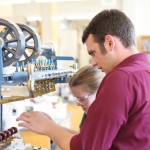USU records record research funding
Editor’s note: This is the first in a two part series about the university’s research funding and some of its research programs.
Utah State University announced its research programs raised $220 million in funding for the 2014 fiscal year. The total is a record for the university.
“It reflects just a strong faculty that are really determined to make a case for the value of their work,” said Mark McLellan, vice president for research. “By making a great case for the value of their work they are attracting resources to make those projects come alive.”
Thirty five percent of USU’s operational budget comes from sponsored research programs.
“It’s a big part of what keeps the entire campus operating and obviously we want to see that continue and hopefully grow,” McLellan said. “This is a good year to show that kind of growth.”
The research projects not only help the university run, but create opportunities for students, both graduate and undergraduate, to gain experience and jobs.
“The funding is the energy source, if you would,” McLellan said. “It allows us to hire students on projects, it allows us to execute the projects. So with this kind of funding about 75 percent of those dollars stays right here, in Cache Valley, in Utah. They fund many different operational aspects from the purchase of new equipment to the hiring of students and technicians. It allows them to actually perform their work.”
One of USU’s most known research programs is the “Spider Goat” project. The program, headed by Professor Randy Lewis, put spider DNA in goats which in turn produce milk with an extra protein. The extra protein makes silk a hundred times stronger than human ligaments.
“One of the reasons that I moved over to Utah State is because I think that we’re at a stage where we need to somewhat change our focus from lab-scale to what I call prototype scale,” Lewis said.
The prototypes include stronger adhesives, parachutes and even bullet proof skin.
“I was contacted by the lady in the Netherlands about a project that she had, again knowing the work we had done, she was interested in doing a project,” Lewis said. “So we were able to provide material, she found some people in the Netherlands who had the capability to grow skin and so they grew their skin on our materials and we came up with bullet proof skin.”
Professor Lewis says he is ready to take his research to the next level, with a process that embraces the current tendencies and needs for American companies.
“It’s clear that with the incredibly risk-averse status that the U.S. companies are in right now they are not willing to put much money out and take chances, I mean it’s just a fact,” Lewis said. “So if we can work with them to make prototypes where they don’t have to make a large investment, we can make a prototype, they can decide if it’s going to work and if it’s going to work then they can put their money into mass producing it.”
According to Lewis the advances of USU’s research funding are an example of innovation for the faculty.
“The latest funding is an example of how we broadened out from the typical sources where we normally were getting funding,” he said. “To broaden out and look for new areas to get funding from.”
The “Spider Goat” project is an example of new information and technology coming directly from the university. Something McLellan thinks is important both for USU and its students.
“It translates to faculty working on leading edge discoveries,” McLellan said. “They bring that to the classroom, the classroom is enriched by that with new discovery, new information so students are not just ‘book learning’ but learning to the current state of the knowledge.”
— dahdahjm@gmail.com
Twitter: @dahdahUSU

